engine coolant CHEVROLET COBALT 2007 1.G Owner's Manual
[x] Cancel search | Manufacturer: CHEVROLET, Model Year: 2007, Model line: COBALT, Model: CHEVROLET COBALT 2007 1.GPages: 450, PDF Size: 2.48 MB
Page 309 of 450
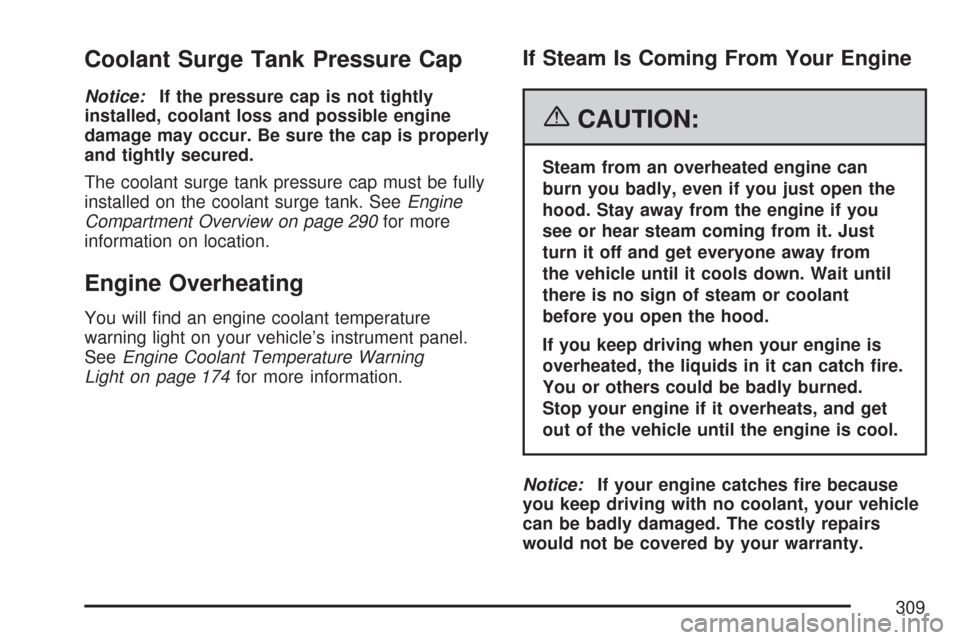
Coolant Surge Tank Pressure Cap
Notice:If the pressure cap is not tightly
installed, coolant loss and possible engine
damage may occur. Be sure the cap is properly
and tightly secured.
The coolant surge tank pressure cap must be fully
installed on the coolant surge tank. SeeEngine
Compartment Overview on page 290for more
information on location.
Engine Overheating
You will �nd an engine coolant temperature
warning light on your vehicle’s instrument panel.
SeeEngine Coolant Temperature Warning
Light on page 174for more information.
If Steam Is Coming From Your Engine
{CAUTION:
Steam from an overheated engine can
burn you badly, even if you just open the
hood. Stay away from the engine if you
see or hear steam coming from it. Just
turn it off and get everyone away from
the vehicle until it cools down. Wait until
there is no sign of steam or coolant
before you open the hood.
If you keep driving when your engine is
overheated, the liquids in it can catch �re.
You or others could be badly burned.
Stop your engine if it overheats, and get
out of the vehicle until the engine is cool.
Notice:If your engine catches �re because
you keep driving with no coolant, your vehicle
can be badly damaged. The costly repairs
would not be covered by your warranty.
309
Page 310 of 450
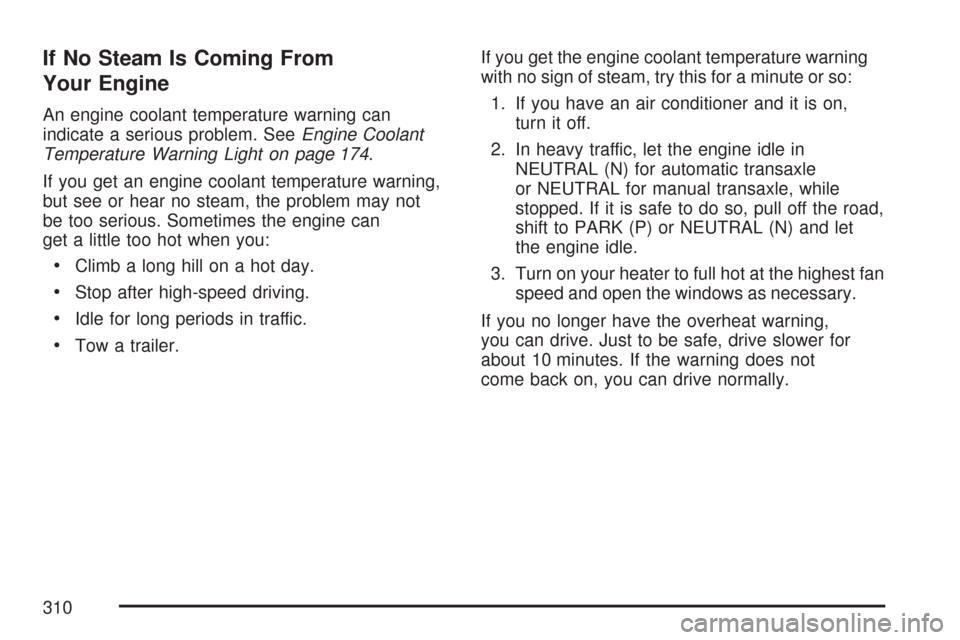
If No Steam Is Coming From
Your Engine
An engine coolant temperature warning can
indicate a serious problem. SeeEngine Coolant
Temperature Warning Light on page 174.
If you get an engine coolant temperature warning,
but see or hear no steam, the problem may not
be too serious. Sometimes the engine can
get a little too hot when you:
Climb a long hill on a hot day.
Stop after high-speed driving.
Idle for long periods in traffic.
Tow a trailer.If you get the engine coolant temperature warning
with no sign of steam, try this for a minute or so:
1. If you have an air conditioner and it is on,
turn it off.
2. In heavy traffic, let the engine idle in
NEUTRAL (N) for automatic transaxle
or NEUTRAL for manual transaxle, while
stopped. If it is safe to do so, pull off the road,
shift to PARK (P) or NEUTRAL (N) and let
the engine idle.
3. Turn on your heater to full hot at the highest fan
speed and open the windows as necessary.
If you no longer have the overheat warning,
you can drive. Just to be safe, drive slower for
about 10 minutes. If the warning does not
come back on, you can drive normally.
310
Page 311 of 450

If the warning continues and you have not
stopped, pull over, stop, and park your vehicle
right away.
If there is still no sign of steam, you can idle the
engine for three minutes while you are parked.
If you still have the warning, turn off the engine
and get everyone out of the vehicle until it
cools down.
You may decide not to lift the hood but to get
service help right away.Cooling System
When you decide it is safe to lift the hood, here is
what you will see:
A. Electric Engine Cooling Fan
B. Coolant Surge Tank and Pressure Cap
2.2L L4 Engine shown, 2.4L L4 Engine similar
311
Page 312 of 450
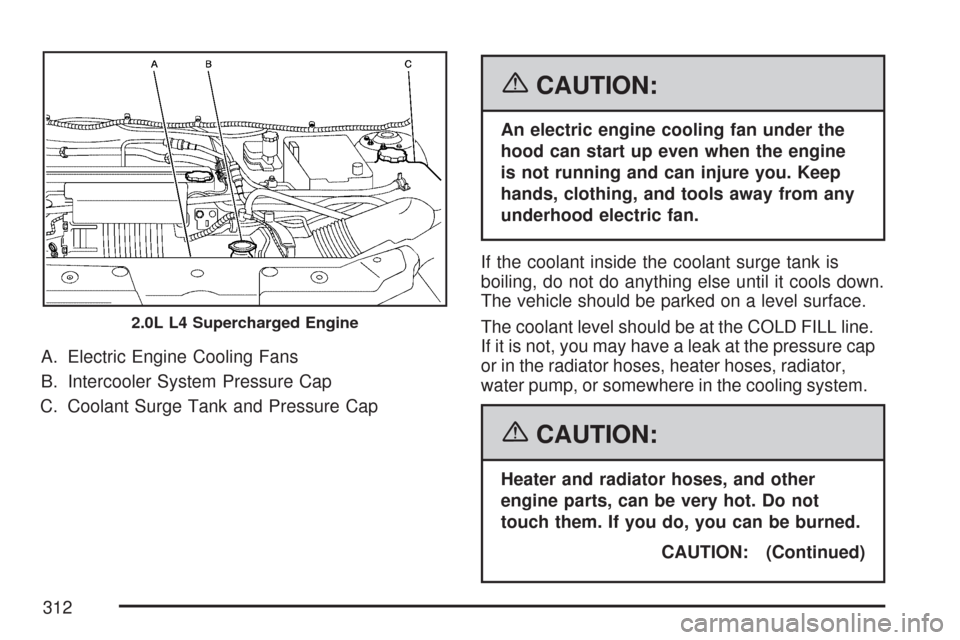
A. Electric Engine Cooling Fans
B. Intercooler System Pressure Cap
C. Coolant Surge Tank and Pressure Cap
{CAUTION:
An electric engine cooling fan under the
hood can start up even when the engine
is not running and can injure you. Keep
hands, clothing, and tools away from any
underhood electric fan.
If the coolant inside the coolant surge tank is
boiling, do not do anything else until it cools down.
The vehicle should be parked on a level surface.
The coolant level should be at the COLD FILL line.
If it is not, you may have a leak at the pressure cap
or in the radiator hoses, heater hoses, radiator,
water pump, or somewhere in the cooling system.
{CAUTION:
Heater and radiator hoses, and other
engine parts, can be very hot. Do not
touch them. If you do, you can be burned.
CAUTION: (Continued)
2.0L L4 Supercharged Engine
312
Page 313 of 450

CAUTION: (Continued)
Do not run the engine if there is a leak.
If you run the engine, it could lose all
coolant. That could cause an engine �re,
and you could be burned. Get any leak
�xed before you drive the vehicle.
If your vehicle is equipped with the 2.2L or
2.4L L4 engine and there seems to be no leak,
with the engine on, check to see if the electric
engine cooling fan is running. If the engine is
overheating, the fan should be running. If it is not,
your vehicle needs service.
If your vehicle is equipped with the
2.0L L4 Supercharged engine and there
seems to be no leak, with the engine on, check to
see if the electric engine cooling fans are running.
If the engine is overheating, the fans should be
running. If they are not, your vehicle needs service.
Notice:Engine damage from running your
engine without coolant is not covered by
your warranty.Notice:Using coolant other than DEX-COOL
®
may cause premature engine, heater core,
or radiator corrosion. In addition, the engine
coolant could require changing sooner,
at 30,000 miles (50 000 km) or 24 months,
whichever occurs �rst. Any repairs would
not be covered by your warranty. Always
use DEX-COOL
®(silicate-free) coolant in
your vehicle.
How to Add Coolant to the Coolant
Surge Tank
Notice:This vehicle has a speci�c coolant �ll
procedure. Failure to follow this procedure
could cause your engine to overheat and
be severely damaged.
If you have not found a problem yet, check to
see if coolant is visible in the coolant surge tank.
If coolant is visible but the coolant level is not at the
COLD FILL line, add a 50/50 mixture of clean,
drinkable water and DEX-COOL
®coolant at the
coolant surge tank, but be sure the cooling system,
including the coolant surge tank pressure cap,
is cool before you do it. SeeEngine Coolant on
page 302for more information.
313
Page 314 of 450
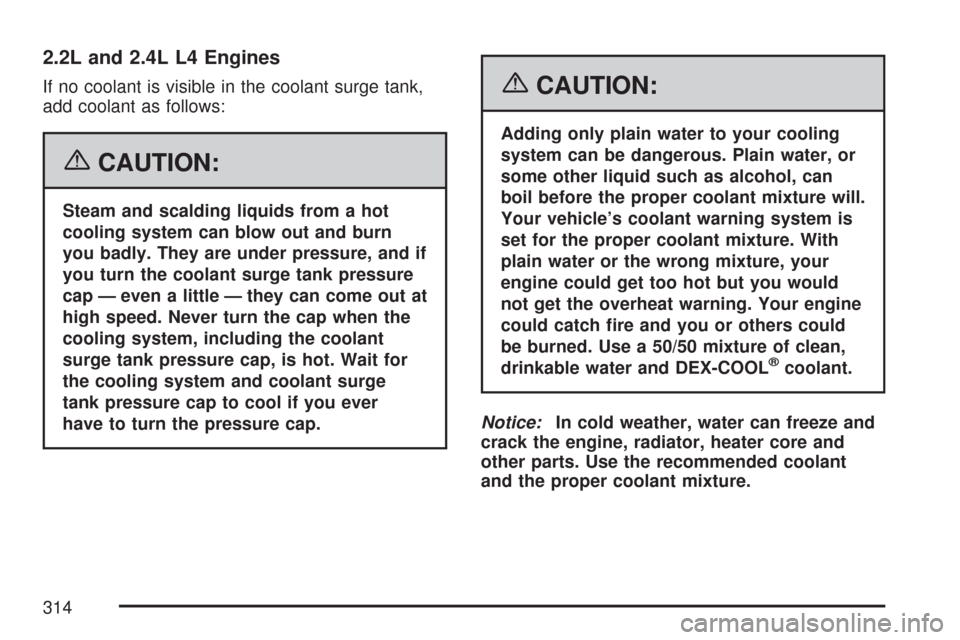
2.2L and 2.4L L4 Engines
If no coolant is visible in the coolant surge tank,
add coolant as follows:
{CAUTION:
Steam and scalding liquids from a hot
cooling system can blow out and burn
you badly. They are under pressure, and if
you turn the coolant surge tank pressure
cap — even a little — they can come out at
high speed. Never turn the cap when the
cooling system, including the coolant
surge tank pressure cap, is hot. Wait for
the cooling system and coolant surge
tank pressure cap to cool if you ever
have to turn the pressure cap.
{CAUTION:
Adding only plain water to your cooling
system can be dangerous. Plain water, or
some other liquid such as alcohol, can
boil before the proper coolant mixture will.
Your vehicle’s coolant warning system is
set for the proper coolant mixture. With
plain water or the wrong mixture, your
engine could get too hot but you would
not get the overheat warning. Your engine
could catch �re and you or others could
be burned. Use a 50/50 mixture of clean,
drinkable water and DEX-COOL
®coolant.
Notice:In cold weather, water can freeze and
crack the engine, radiator, heater core and
other parts. Use the recommended coolant
and the proper coolant mixture.
314
Page 315 of 450

{CAUTION:
You can be burned if you spill coolant
on hot engine parts. Coolant contains
ethylene glycol and it will burn if the
engine parts are hot enough. Do not
spill coolant on a hot engine.
1. You can remove the coolant surge tank
pressure cap when the cooling system,
including the coolant surge tank pressure
cap and upper radiator hose, is no longer hot.
Turn the pressure cap slowly counterclockwise
about two or two and one-half turns. If you
hear a hiss, wait for that to stop. This will allow
any pressure still left to be vented out the
discharge hose.2. Then keep
turning the
pressure cap
slowly, and
remove it.
315
Page 316 of 450
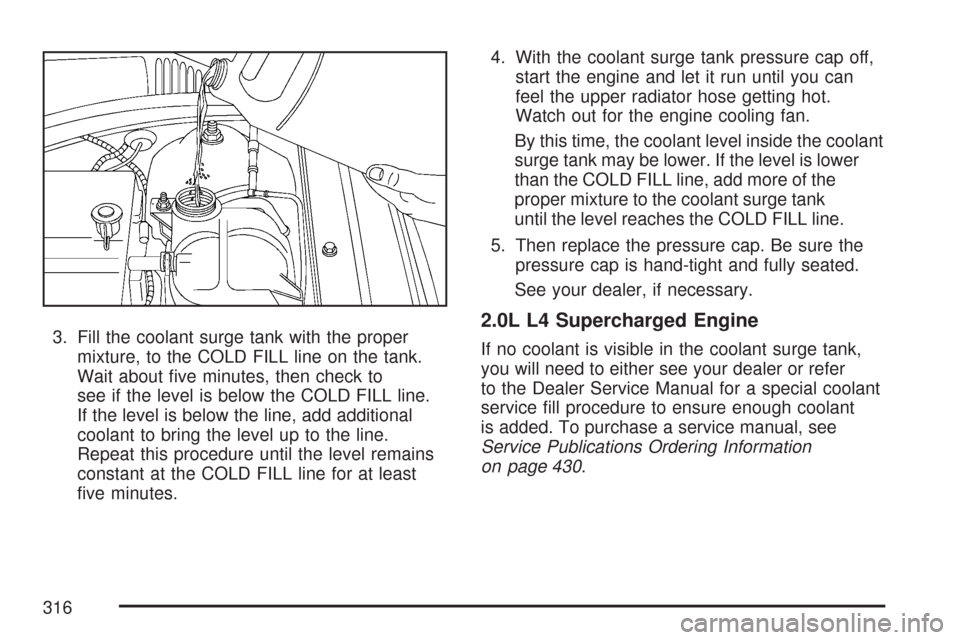
3. Fill the coolant surge tank with the proper
mixture, to the COLD FILL line on the tank.
Wait about �ve minutes, then check to
see if the level is below the COLD FILL line.
If the level is below the line, add additional
coolant to bring the level up to the line.
Repeat this procedure until the level remains
constant at the COLD FILL line for at least
�ve minutes.4. With the coolant surge tank pressure cap off,
start the engine and let it run until you can
feel the upper radiator hose getting hot.
Watch out for the engine cooling fan.
By this time, the coolant level inside the coolant
surge tank may be lower. If the level is lower
than the COLD FILL line, add more of the
proper mixture to the coolant surge tank
until the level reaches the COLD FILL line.
5. Then replace the pressure cap. Be sure the
pressure cap is hand-tight and fully seated.
See your dealer, if necessary.2.0L L4 Supercharged Engine
If no coolant is visible in the coolant surge tank,
you will need to either see your dealer or refer
to the Dealer Service Manual for a special coolant
service �ll procedure to ensure enough coolant
is added. To purchase a service manual, see
Service Publications Ordering Information
on page 430.
316
Page 317 of 450
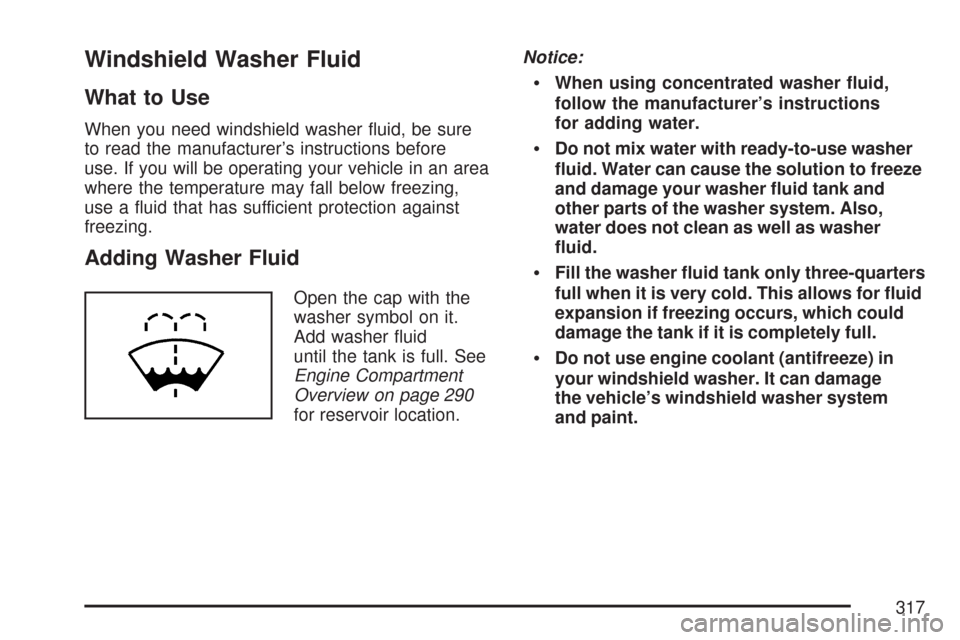
Windshield Washer Fluid
What to Use
When you need windshield washer �uid, be sure
to read the manufacturer’s instructions before
use. If you will be operating your vehicle in an area
where the temperature may fall below freezing,
use a �uid that has sufficient protection against
freezing.
Adding Washer Fluid
Open the cap with the
washer symbol on it.
Add washer �uid
until the tank is full. See
Engine Compartment
Overview on page 290
for reservoir location.Notice:
When using concentrated washer �uid,
follow the manufacturer’s instructions
for adding water.
Do not mix water with ready-to-use washer
�uid. Water can cause the solution to freeze
and damage your washer �uid tank and
other parts of the washer system. Also,
water does not clean as well as washer
�uid.
Fill the washer �uid tank only three-quarters
full when it is very cold. This allows for �uid
expansion if freezing occurs, which could
damage the tank if it is completely full.
Do not use engine coolant (antifreeze) in
your windshield washer. It can damage
the vehicle’s windshield washer system
and paint.
317
Page 324 of 450

The remote positive
terminal is located
under a red tethered
cap on the engine
compartment fuse block.
Lift the cap to access
the terminal.
The remote negative (−)
ground terminal, marked
GND (−), is located
behind the engine
coolant surge tank.SeeEngine Compartment Overview on
page 290for more information on the location
of the positive (+) and negative (−) terminals
on your vehicle.
{CAUTION:
An electric fan can start up even when the
engine is not running and can injure you.
Keep hands, clothing and tools away from
any underhood electric fan.
324